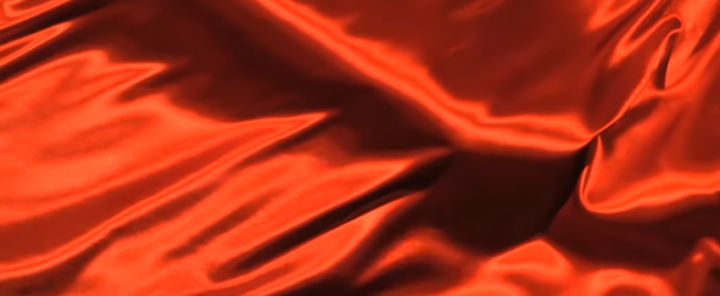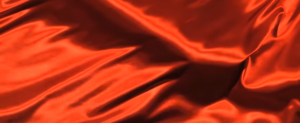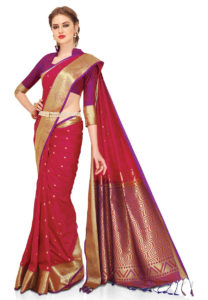
Silk Fabric
Silk fabric, also known as ‘Paat’ in East India, Pattu in South India and Resham in North India, is a natural fiber produced from the cocoons of mulberry silkworm via a process called Sericulture. The yarns produced from the process of sericulture are used to weave a variety of textiles.

Lustrous Silk Fabric (source: youtube)
The fabric has a shimmering appearance, though has interrupting patterns of weave due to its natural fibre. The triangular prism-like structure allows the fabric to refract the lights, hence producing various colors in different lighting. Today, India is world’s second largest producer of silk after China. Not only that, India is also the largest consumer of Silk, Celebrations playing vital role in day to day life of any Indian.
Origin & History
The origin of Silk dates back to Indus Valley Civilization between 2450 BC and 2000 BC. However, the origins are still also seen 2500 BC in China.
The processing techniques of Silk – degumming and reeling, were taken from the Chinese technology, where Silk was originally believed to be born. Majorly, 97% of the raw silk comes from five Indian states – Andhra Pradesh, Karnataka, Jammu and Kashmir, Tamil Nadu and West Bengal.
Various Types & Forms of Silk in India
- Tanchoi Silk: Weaving technique which is a blend of silk from the two countries, India and China.
- Garad Silk: Garad originates in West Bengal, and is distinguished by its red border and small paisley motifs. Silk fabric used to weave Garad sarees is produced by the silk yarns woven close together which imparts the fine texture.
- Jamawar: Jamawar Silk is an adulterated form of Pashmina silk which contains a blend of cotton and wool. This is usually used in weaving shawls for the winters.
- Matka Silk: A rough handloom silk fabric made from the waste Mulberry Silk without removing its gum (sericin) part, largely produced in Karnataka and Kashmir.
- Banarasi/Benarasi Silk: A fine variant of silk evolving from the lands of Beneras or Varanasi, known for gold and silver work of brocade and zari on the fabric.
- Mulberry Silk: Purest form of silk extracted from Silkworms, usually produced in yellow, white, or greenish yellow color.
- Murshidabad Silk: Silk produced at the ‘Silk Mecca’ of East India.
- Bangalore Silk: Known for its simplicity and purity of Silk, Bangalore silk is produced in the silk farms of Bangalore.
- Angora Silk: Known for tender texture, the Angora silk yarn is made up from the fur of meek ‘Angora’ rabbit.
- Silk Embroidery: Intricate patterns embroidered in silk on various fabrics.
- Pochampally/Pochampalli Silk: Type of silk originating from the town of Boodhan Pochampally, located in Nalgonda district of Andhra Pradesh, popularly known as the silk city of India.
- Mysore Silk Crepe: Woven from hard spun silk yarn and comes from the silk city of Mysore in Karnataka.
- Sournachuri Silk: Originating from West Bengal, Sournachuri Silk has gold thread incorporated in the weave of silk, hence giving a rich shine to the fabric. It is also known as the ‘illustrious’ sister of the Baluchari Silk saree.
- Raw Silk: Raw Silk is the most natural form of delicate fibre of silk with no twist and is unprocessed form of silk that can be easily woven into different fabrics.
- Kosa Silk: Comes from Chattisgarh, and is known for its soft texture and dull-brownish look, hence available in shades of gold pale, dark honey, cream, etc. Kosa is one kind of Tussar Silk.
- Tussar Silk: Also known as Wild Silk, Tussar radiates gold sheen in its fabric and is exclusively produced in India.
- Muga Silk: Produced only in Assam, Muga silk yarns are totally yellow in color and is considered as strongest natural fibre
- Eri Silk: Also known as Errandi and Endi in most parts of India, Eri Silk is the purest forms of silk from the east, with a dull yellow, gold like sheen.
- Dharamavaram Silk: Known for gold-plated borders, Dharamavaram silk orginates from Andhra Pradesh, and is also known as ‘Silk for the Bride.’
- Narayanpet Silk: Originates from Andhra Pradesh, the textiles of Narayanpet have a checked surface design with embroidery and the border or pallu have intricate ethnic designs such as a temple.
- Pat/Paat Silk: Produced in Eastern India, Pat silk is known for its distinctive brightness, high quality and durable nature. It comes in brilliant white or off-white shades.
- Cot Silk: A well-blended combination of cotton and silk, Cot silk is a cheaper-priced silk.
- Kanchipuram: Silk from the village called Kanchipuram in Tamil Nadu, India, this one is known for its durability and shine. The rich quality combined with an amazing finish make them last longer.
- Bhagalpuri Silk: Known as the ‘Queen of all fabrics’, Bhagalpuri Silk originates from West Bengal and is very well known for its unique and striking resilience and superior quality.
- Uppada Silk: Also known as Uppada Pattu (Silk in Telugu), Uppada silk comes from Andhra Pradesh. Usually woven in cotton warp, this one is known majorly by the length and breadth count of threads.
- Art Silk: Short form for artificial silk, art silk is manufactured by a synthetic fiber like Rayon that very much resembles the silk fiber; however, costs a lot less on the front of manufacture and production.
Knowing & Maintaining Silk
Since it is a natural fiber, Silk has a smooth and soft texture. The elasticity of a silk fabric is poor, hence if stretched; it takes the shape as it is. It can be weakened if exposed to too much sunlight. It may also be attacked by insects, especially if left dirty.
Unwashed silk chiffon may shrink up to 8% due to a relaxation of the fiber macrostructure, so silk should either be washed prior to garment construction, or dry cleaned. Dry cleaning may still shrink the chiffon up to 4%. Occasionally, this shrinkage can be reversed by a gentle steaming with a press cloth. There is almost no gradual shrinkage nor shrinkage due to molecular-level deformation.
Important Facts about Silk
- The strength of Silk is equivalent to a metal wire.
- It takes about 10 kg of cocoons to obtain 1 kg of silk.
References
Categories: Textiles

